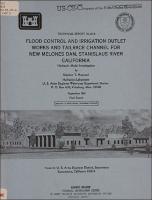Please use this identifier to cite or link to this item:
https://hdl.handle.net/11681/13476Full metadata record
| DC Field | Value | Language |
|---|---|---|
| dc.contributor | United States. Army. Corps of Engineers. Sacramento District | - |
| dc.contributor.author | Maynord, Stephen T. | - |
| dc.date.accessioned | 2016-07-18T15:33:43Z | - |
| dc.date.available | 2016-07-18T15:33:43Z | - |
| dc.date.issued | 1981-09 | - |
| dc.identifier.uri | http://hdl.handle.net/11681/13476 | - |
| dc.description | Technical Report | - |
| dc.description | Abstract: A model study of the flood control and irrigation (FC&I) outlet works and tailrace channel for New Melones Dam was conducted to develop measures to stabilize the tailrace channel. During the initial operation of the prototype FC&I outlet works, flows at a relatively low pool elevation resulted in failure of the 4-ft-diam derrick stone on the opposite bank. Several alternatives were tested in the 1:24-scale model. In the first alternative the existing concrete chute and impingement pad located downstream of the two 78-in.-diam fixed-cone valves were modified to form a basin similar in concept to an impact basin. This design resulted in adequate energy dissipation but concern for the structural integrity and the cost of this basin eliminated this alternative. The second alternative evaluated in the model was a plunge pool or preformed scour hole concept. The plunge pool was not effective because the length available was too short for adequate energy dissipation, and the angle at which the jet entered the pool caused the jet to ride along the surface rather than plunge and dissipate energy throughout the depth of the pool. The third design tested in the model involved increasing the tailwater by means of an inflatable dam located downstream in the tailrace channel. An inflatable or removable dam would be required so that it could be lowered during power generation and raised during FC&I outlet works operation. Increased tailwater together with a partial plunge pool resulted in adequate energy dissipation but possible operation problems and the cost of the inflatable dam excluded this alternative. The recommended design consisted of the addition of deflector plates to the 18-ft- diam hoods and baffle blocks and an end sill added to the existing concrete chute and impingement pad. This design resulted in good energy dissipation at all flows. The loadings exerted on the baffle blocks and end sill were measured in the 1:24-scale model. The loadings and pressures exerted on the deflector plates were measured in a 1:12- scale model. These loadings were used in the structural design of the elements of the recommended design. Although low-pressure zones were found in the deflector plate design, the high level of aeration that occurs when fixed- cone valves discharge into freely aerated hoods should reduce the potential for cavitation damage. Aeration of flow within the hoods was supplemented by air vents located between the deflector plates. | - |
| dc.publisher | Hydraulics Laboratory (U.S.) | - |
| dc.publisher | Engineer Research and Development Center (U.S.) | - |
| dc.relation | http://acwc.sdp.sirsi.net/client/en_US/search/asset/1033467 | - |
| dc.relation.ispartofseries | Technical report (U.S. Army Engineer Waterways Experiment Station) ; HL-81-6. | - |
| dc.rights | Approved for public release; distribution is unlimited. | - |
| dc.source | This Digital Resource was created from scans of the Print Resource | - |
| dc.subject | Flood control | - |
| dc.subject | Hydraulic models | - |
| dc.subject | Irrigation | - |
| dc.subject | Outlet works | - |
| dc.subject | New Melones Dam | - |
| dc.subject | California | - |
| dc.subject | Stanislaus River | - |
| dc.subject | Tailraces | - |
| dc.subject | Hydraulic structures | - |
| dc.title | Flood control and irrigation outlet works and tailrace channel for New Melones Dam, Stanislaus River, California : hydraulic model investigation | - |
| dc.type | Report | en_US |
| Appears in Collections: | Technical Report | |
Files in This Item:
| File | Description | Size | Format | |
|---|---|---|---|---|
| TR-HL-81-6.pdf | 7.32 MB | Adobe PDF |  View/Open |